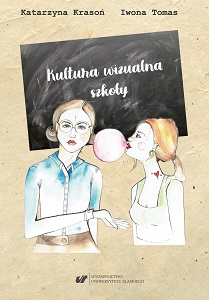Kultura wizualna szkoły. Szkice o wizerunku nauczyciela i ucznia oraz o potrzebie estetyki przestrzeni nauczania-uczenia się
School visual culture.: On the image of the teacher and the student and the need for aesthetics of teaching and learning space
Author(s): Katarzyna Krasoń , Iwona Tomas
Subject(s): Social Sciences, Education
Published by: Wydawnictwo Uniwersytetu Śląskiego
Keywords: school visuality; school iconosphere; teacher and student image; school space aesthetics
Summary/Abstract: The main aim of the book is to present the distinctive semiotics of the contemporary Polish school, with particular emphasis on its visual aspects. This concerns various forms of visual self-presentation of students and teachers as a means of expressing their independence or, sometimes, as a means of self-concealment. Another theme addressed is the iconosphere of the school environment, including the school’s own products in this area (such as school decorations, current event boards, school newspapers, memorial boards, and the aesthetics of the hall, the classroom, and the school surroundings). Central to this approach to school culture in terms of aesthetic categories is the concept of culture “embodied in symbols” (referred to by Clifford Geertz as a symbolic concept). The book situates this notion in teachers’ and students’ experience of reality, referring to Luigi Pareyson’s view – another idea which provides the theoretical foundation for this project – that aesthetics should be a reflection on experiences which need to be interpreted in order to define their meanings and investigate their sense. Thus, the volume implements both theoretical frameworks to discuss school semiotics in aesthetic terms in an attempt to fill the gap in systematic reflection on the aesthetic aspects of school culture.The approach taken in this book is close to semiotics, hermeneutics, and phenomenology, which provide the roots for interpretive anthropology, focused on the researcher’s interpretation of culture. In this case, each respondent becomes a researcher who interprets culture (aesthetics), which is then interpreted by the scholar (the organiser of the investigations). Thanks to this procedure, it is possible to juxtapose the knowledge of the scholar with so-called local knowledge.The first part of the book addresses the problems of culture, including visual culture, aesthetics (including everyday aesthetics), antiaesthetics, and kitsch; it also refers to self-presentation and ubiquitous sight-centrism, which are central issues in this research project. It discusses the everyday semiotic culture of the school, thus providing an analysis of whatever functions as a sign of the student’s and teacher’s self-presentation in a social situation, that is, a way of communicating their identity. The focus is on the visual aspects of self-presentation, namely, the dress code, which is subject to fashion.The second part is concerned with selected issues in interpretive anthropology, since it is this kind of anthropology that provides the methodological foundations for the project. It presents the main problems addressed and formulates the following research questions:- What is the present condition of the aestheticisation of the school with regard toiconicity, proxemics and the teacher’s and student’s self-presentation?- In what way does the school determine the emergence or absence of aesthetic taste?- What are the results of the marginalisation of culture and aesthetics in school andwhat can be done to reverse this process?The final part presents the results of the anthropological-pedagogical investigations, taking into consideration Geertz’s appeal for a detailed thick description. The analysis and interpretation of the collected material take into account the visual aspects and the iconosphere.Special attention is given to some worrying phenomena, not limited to the school environment, which involve relegating arts and aesthetics to areas ignored or considered as marginal from the perspective of education, including underestimating the role of participation in culture as a key factor in both aesthetic and creative development of students.It is hoped that the results of the research will raise awareness of the need for greater care for the aesthetic characteristics of space and material surroundings in which the process of education takes place, point out the dangers related to the tolerance for kitsch and symbolic violence, and draw attention to the importance of a better understanding of the ways of self-expression – related to individual dress codes – by the participants in the teaching and learning process. These data may prove especially useful for those responsible for the visual organisation of school environment and for designing learning-friendly space.
Series: Pedagogika, Dydaktyka
- E-ISBN-13: 978-83-226-3772-2
- Print-ISBN-13: 978-83-226-3771-5
- Page Count: 240
- Publication Year: 2019
- Language: Polish
- eBook-PDF
- Table of Content
- Introduction

